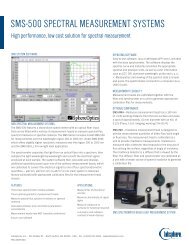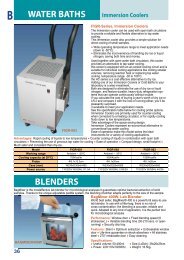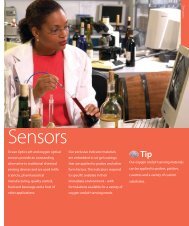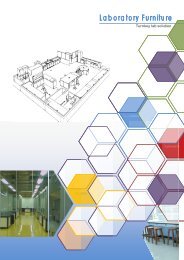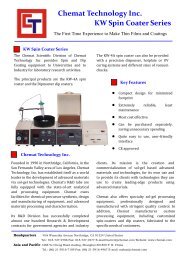S p e ctro m ete rs Ocean Optics pioneered the concept of ... - NDN
S p e ctro m ete rs Ocean Optics pioneered the concept of ... - NDN
S p e ctro m ete rs Ocean Optics pioneered the concept of ... - NDN
Create successful ePaper yourself
Turn your PDF publications into a flip-book with our unique Google optimized e-Paper software.
USB Series Spe<strong>ctro</strong>m<strong>ete</strong><strong>rs</strong> Overview<br />
Choosing <strong>the</strong> Best USB2000+ or USB4000 Option for Your Application<br />
<strong>Ocean</strong> <strong>Optics</strong> USB-series spe<strong>ctro</strong>m<strong>ete</strong><strong>rs</strong> are ve<strong>rs</strong>atile performe<strong>rs</strong> for a wide array <strong>of</strong> applications. Although our flagship USB2000+ and USB4000<br />
spe<strong>ctro</strong>m<strong>ete</strong><strong>rs</strong> have comparable ele<strong>ctro</strong>nics and architecture, <strong>the</strong>y do have one very important difference: <strong>the</strong>ir linear CCD array d<strong>ete</strong>cto<strong>rs</strong>. In addition,<br />
USB2000+ and USB4000 spe<strong>ctro</strong>m<strong>ete</strong><strong>rs</strong> are available in application-ready (preconfigured for specific application types) and build-your-own (userconfigured<br />
for maximum flexibility) ve<strong>rs</strong>ions.<br />
Comparing <strong>the</strong> USB2000+ and USB4000 Spe<strong>ctro</strong>m<strong>ete</strong><strong>rs</strong><br />
The USB2000+ has a 2048-element Sony ILX511B d<strong>ete</strong>ctor and <strong>the</strong> USB4000 has <strong>the</strong> 3648-element Toshiba TCD1304AP d<strong>ete</strong>ctor. Both are linear silicon<br />
CCD arrays, with an effective range <strong>of</strong> 200-1100 nm, and are available with <strong>the</strong> same optical bench accessory options (quartz window for UV performance,<br />
order-sorting filte<strong>rs</strong> and so on).<br />
Spe<strong>ctro</strong>m<strong>ete</strong><strong>rs</strong><br />
Advantages <strong>of</strong> <strong>the</strong> USB2000+<br />
- Its Sony ILX511B d<strong>ete</strong>ctor is coated with a phosphor for better response in <strong>the</strong> UV,<br />
making it especially useful for applications below 350 nm.<br />
- It has a faster minimum integration time – 1 ms compared with 3.8 ms for <strong>the</strong><br />
USB4000. That’s an advantage for applications involving transient events such as<br />
measuring a pulsed light source.<br />
- In applications where you have a considerable amount <strong>of</strong> light, its faster integration<br />
time helps you avoid saturating <strong>the</strong> d<strong>ete</strong>ctor.<br />
Advantages <strong>of</strong> <strong>the</strong> USB4000<br />
- It has better response at wavelengths beyond 400 nm, making it a good choice for<br />
VIS-Shortwave NIR applications.<br />
- Its signal to noise ratio (300:1) and sensitivity (130 photons/count @ 400 nm) are<br />
slightly better than that for <strong>the</strong> USB2000+. This is important in low-light level<br />
applications.<br />
- It’s slightly less expensive than <strong>the</strong> USB2000+. Both systems <strong>of</strong>fer great value at a<br />
reasonable price. But if you’re equipping a lab with multiple units and are primarily<br />
working in <strong>the</strong> VIS-NIR, <strong>the</strong> per-unit savings you realize could be applied to completing<br />
your order with our light sources, accessories and o<strong>the</strong>r complementary products.<br />
USB Series Spe<strong>ctro</strong>m<strong>ete</strong>r Models at a Glance<br />
You can configure a USB2000+ or USB4000 with gratings and optical bench accessories for a myriad <strong>of</strong> application possibilities. Or, over <strong>the</strong> next<br />
several pages, investigate one <strong>of</strong> <strong>the</strong> nearly 10 different application-ready USB2000+/USB4000 systems described in <strong>the</strong> table below:<br />
General Use<br />
Best for USB2000+ Series USB4000 Series<br />
USB2000+UV-VIS<br />
USB2000+VIS-NIR<br />
USB4000-UV-VIS<br />
USB4000-VIS-NIR<br />
Extended range (200-1050 nm) USB2000+XR1 USB4000-XR1<br />
Fluorescence No preconfigured models USB4000-FL (several excitation wavelength options)<br />
Irradiance USB2000+RAD No preconfigured models<br />
www.oceanoptics.com Tel: +1 727-733-2447 9







